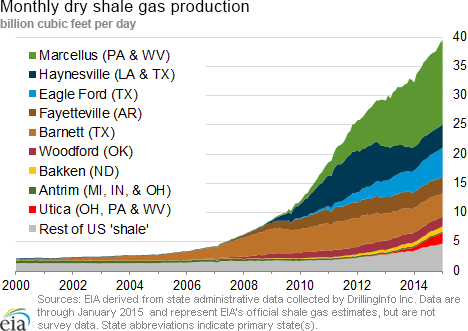In the News:
Despite decline in rigs, natural gas production forecast to increase
The total U.S. rig count as of March 6 was 1192, 600 lower than year-ago levels, according to data from Baker Hughes. Nearly 87% of the decline was from rigs designated as targeting oil, and more than half of this year-over-year decline occurred in Texas, where rig levels over last year fell by 326. The decline in Texas was driven by rig count declines of 173 and 73 in the Permian and Eagle Ford basins, respectively. The remainder of the overall decline, 13%, came from lower natural gas rig levels. As of March 6, only 26% (268) of total rigs were designated as targeting natural gas, a decrease of 77 rigs compared with last year's natural gas rig levels.
Despite declining rig counts, EIA forecasts continued growth in natural gas production over the next two years. In the past, the number of gas-oriented drilling rigs in a particular region was a common metric for estimating the production of natural gas. However, over the last several years, natural gas production has steadily increased, while the number of active rigs characterized as targeting natural gas has fallen dramatically.
There are several reasons that have contributed to the breakdown of traditional methods that seek to estimate natural gas production based principally on rig counts. To start, with the development of shale resources, there is an increased integration of oil and gas production, and natural gas is often produced from rigs that are targeting oil. Additionally, there have been increases in drilling efficiency, or the number of wells drilled per rig each month.
There is also a backlog of wells that have been drilled but not yet completed, which acts as a cushion for well additions, offsetting the more immediate decreases in drilling and permitting activity. As of the end of January, at most major plays in the United States, the backlog ranged from three to seven months. However, when drilling activity remains at reduced levels long enough to outlast the cushioning effect of the well-completion backlog, the number of new wells brought online will begin to decrease, which can eventually reduce production rates. Additionally, production may decline should producers defer completions.
In December 2014, dry natural gas production hit a record high of 74.3 billion cubic feet per day (Bcf/d), according to EIA's Natural Gas Monthly. This production increase occurred despite declining prices and falling rig counts. For 2014 as a whole, natural gas production increased 6.1%, which was the strongest growth since 2011, despite a 13% decrease in average natural gas rig count levels in 2014 compared with 2013. In the first two month of 2015, preliminary natural gas production data indicate temporary declines, largely attributable to freeze-offs during a few cold weeks in January and February. However, based on increases in rig efficiency and recent data, EIA's March Short-Term Energy Outlook forecasts that 2015 natural gas production will average 73.9 Bcf/d, an increase of 5% over 2014 levels. EIA forecasts that for 2016, production will average 75.4 Bcf/d, a 2% year-over-year growth.
Overview:
(For the Week Ending Wednesday, March 11, 2015)
- With more seasonal temperatures, natural gas prices moved downward at most trading locations during the report week (Wednesday to Wednesday). The Henry Hub spot price fell 47¢ over the report week, from $3.26/million British thermal units (MMBtu) last Wednesday to $2.79/MMBtu yesterday.
- At the New York Mercantile Exchange (Nymex), the April contract started the week at $2.769/MMBtu last Wednesday, fluctuated slightly and settled up at $2.824/MMBtu yesterday.
- Working natural gas in storage decreased to 1,512 Bcf as of Friday, March 6, according to the U.S. Energy Information Administration (EIA) Weekly Natural Gas Storage Report (WNGSR). A net withdrawal from storage of 198 Bcf for the week resulted in storage levels 46.9% above year-ago levels and 13.0% below the five-year average for this week.
- As of March 6, there were 1,192 total rigs operating in the United States. The natural gas rig count fell by 12 to 268, and the oil rig count fell by 64 to 922. Additionally, two miscellaneous rigs were in operation this week.
- The natural gas plant liquids composite price increased by 1¢ to $5.93/MMBtu for the week ending March 6. Mont Belvieu NGL spot prices were mixed this week. Natural gasoline decreased by 0.3%, propane rose 1.7%, butane rose by 0.9%, and isobutane increased by 1.5%. Ethane prices dropped 6.7%.
Prices/Demand/Supply:
Moderating temperatures mark the approach of spring, prices drop. Natural gas prices at almost all trading locations fell Wednesday to Wednesday as temperatures climbed to normal or near-normal levels, after a chilly start to the week. At most locations, prices fell through Tuesday, before rebounding slightly in trading on Wednesday, offsetting some of the report-week losses. The Henry Hub spot price opened the report week at $3.26/MMBtu and lost 53¢ through Tuesday, before gaining 6¢ in trading on Wednesday to end the week at $2.79/MMBtu.
Northeast posts overall price declines. At the Algonquin Citygate, which serves Boston, prices started the week $13.98/MMBtu on Wednesday, fell to $3.07/MMBtu on Tuesday, and ended the week at $4.97/MMBtu. Expected higher power demand in New England on Thursday, as reported by the New England Independent System Operator, supported the $1.97/MMBtu increase in gas prices in trading yesterday. Similarly, with winter weather at the start of the report week, prices at the Transcontinental Zone 6 trading point for delivery into New York City began the week relatively high at $15.83/MMBtu, before closing at $2.75/MMBtu yesterday.
With forecasts that called for warmer weather through the week, prices also fell significantly at locations in the Mid-Atlantic and Midwest. For example, prices at Transcontinental Zone 5, with service into the Mid-Atlantic, fell $11.67, to end the week at $2.79/MMBtu. At the Chicago Citygate, the natural gas price dropped more than $2 from $4.98/MMBtu last Wednesday to $2.75/MMBtu yesterday.
Marcellus-area prices remain low. Prices at several trading locations in the Marcellus area were among the few that increased this week. Despite this, prices in the Marcellus remain the lowest in the country. At Tennessee's Zone 4 trading region, which represents Marcellus deliveries on Tennessee's pipeline system, prices began the week at $1.30/MMBtu, dropped 10¢ to $1.20/MMBtu on Friday, before ending the week up at $1.40/MMBtu. Prices on Transco's Leidy Line also ended the report week at $1.40/MMBtu, an increase of 2¢ Wednesday to Wednesday. Prices at Dominion South, which serves customers in portions of Pennsylvania, Ohio, Maryland, West Virginia, and Virginia, started the week relatively higher than other Marcellus locations. Unlike the other Marcellus locations, Dominion South had an overall decline for the report week, closing the week at $1.67/MMBtu.
Nymex prices increase. At the Nymex, the near-month April contract increased this week from $2.769/MMBtu last Wednesday to $2.824/MMBtu yesterday. Supporting this increase were expectations of a report of a larger-than-normal storage withdrawal. The 12-month strip (the average of the 12 contracts between April 2015 and March 2016) increased from $2.919/MMBtu last Wednesday to $2.952/MMBtu yesterday.
Supply declines slightly. Total natural gas supply declined 0.1% from last week. As temperatures moved closer to normal levels, imports of natural gas from Canada declined 5.2% from the previous week, with imports in all regions dropping. Sendout of LNG also declined from last week. The decline in imported gas was offset by a week-over-week 0.6% increase in dry gas production. Dry gas production for the report week is 8.7% greater than the same week last year.
Consumption falls below supply in the second half of the report week. Led by declines in the residential and commercial sectors, consumption continues to fall. Since March 8, supply has exceeded consumption, the first multiday period that this has occurred since late December 2014. Total domestic consumption fell 17.5% week over week, but was nearly 10% greater than the same week last year. Residential and commercial consumption fell 28.5% from last week, with consumption moving lower through the report week. Industrial consumption declined 5.3%. Overall consumption of gas for electric power generation (power burn) fell 3.9%, but there were some regional variations. In particular, power burn increased in the Midwest by 13.4%.
Storage
Storage inventories fall further below five-year average. After surpassing their five-year average three weeks ago, natural gas stocks remain below their five-year average following three weeks of larger-than-average withdrawals. With a net withdrawal of 198 Bcf for the week, working gas inventories as of March 6 totaled 1,512 Bcf, 483 Bcf (46.9%) higher than last year at this time and 225 Bcf (13.0%) lower than the five-year (2010-14) average. The 198-Bcf net withdrawal reported for the week was higher than both the five-year average and last year's net withdrawals for the week ending March 6, which were 116 Bcf and 189 Bcf, respectively.
Storage withdrawals are higher than market expectations. Market expectations, on average, called for a pull of 191 Bcf. With the larger-than-expected withdrawal, when the EIA storage report was released at 10:30 a.m. on March 12, the price for the April natural gas futures contract decreased a few cents in the minutes following the release, to $2.83/MMBtu, in trading on the Nymex. In the next hour, prices decreased further, trading around $2.81/MMBtu.
Salt facilities in the Producing region are now below their five-year average. With a 78-Bcf storage withdrawal this week, the Producing region remains below its five-year average by 128 Bcf. Salt facilities in that region are now below their five-year average by 18 Bcf, compared with their 2-Bcf surplus from the week before. The deficit to their five-year average from nonsalt facilities in the Producing region also grew this week, and is now 110 Bcf (19.7%) below the five-year average. The West region is the only region above its five-year average. Storage levels for the East, West, and Producing regions were above their year-ago levels by 174 Bcf, 167 Bcf, and 142 Bcf, respectively.
Temperatures during the storage report week are still significantly cooler than normal. Temperatures in the Lower 48 states averaged 31.4° for the storage report week, 9.4° cooler than the 30-year normal temperature, but 1.3° warmer than the average temperature during the same week last year. There were 238 population-weighted heating degree days during the storage report week, 69 greater than the 5-year average and 8 fewer than during the same period last year.
See also:
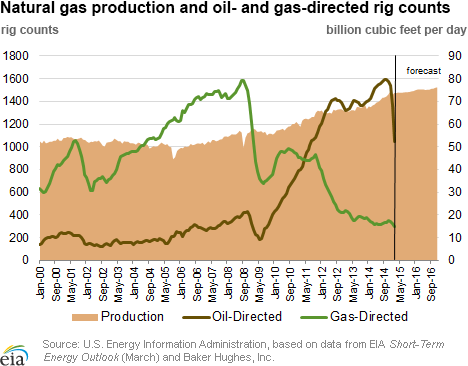
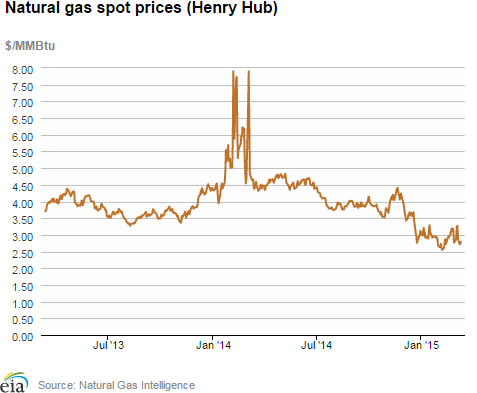
| Spot Prices ($/MMBtu) | Thu, 05-Mar |
Fri, 06-Mar |
Mon, 09-Mar |
Tue, 10-Mar |
Wed, 11-Mar |
|---|---|---|---|---|---|
| Henry Hub |
3.27 |
2.88 |
2.72 |
2.73 |
2.79 |
| New York |
13.89 |
3.13 |
2.65 |
2.58 |
2.75 |
| Chicago |
3.40 |
2.84 |
2.68 |
2.69 |
2.75 |
| Cal. Comp. Avg,* |
2.74 |
2.68 |
2.60 |
2.61 |
2.67 |
| Futures ($/MMBtu) | |||||
| April contract |
2.841 |
2.839 |
2.678 |
2.732 |
2.824 |
| May contract |
2.880 |
2.872 |
2.713 |
2.763 |
2.850 |
| *Avg. of NGI's reported prices for: Malin, PG&E citygate, and Southern California Border Avg. | |||||
| Source: NGI's Daily Gas Price Index | |||||
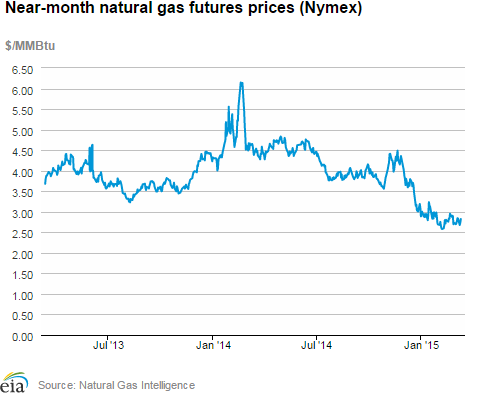
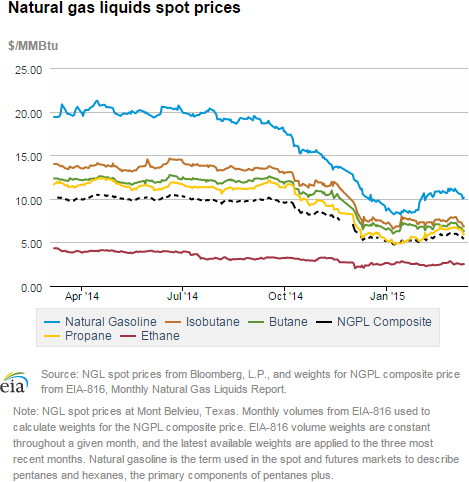
| U.S. natural gas supply - Gas Week: (3/4/15 - 3/11/15) | ||
|---|---|---|
Percent change for week compared with: |
||
last year |
last week |
|
| Gross production | 8.81%
|
0.60%
|
| Dry production | 8.73%
|
0.60%
|
| Canadian imports | 19.97%
|
-5.22%
|
| West (net) | 43.68%
|
-1.61%
|
| Midwest (net) | -33.98%
|
-12.34%
|
| Northeast (net) | 60.92%
|
-7.31%
|
| LNG imports | 119.26%
|
-42.59%
|
| Total supply | 9.65%
|
-0.11%
|
| Source: BENTEK Energy LLC | ||
| U.S. consumption - Gas Week: (3/4/15 - 3/11/15) | ||
|---|---|---|
Percent change for week compared with: |
||
last year |
last week |
|
| U.S. consumption | 9.9%
|
-17.5%
|
| Power | 33.3%
|
-3.9%
|
| Industrial | -0.2%
|
-5.3%
|
| Residential/commercial | 5.1%
|
-28.5%
|
| Total demand | 10.5%
|
-17.2%
|
| Source: BENTEK Energy LLC | ||
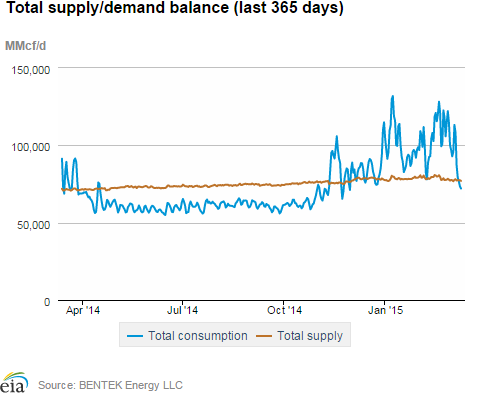
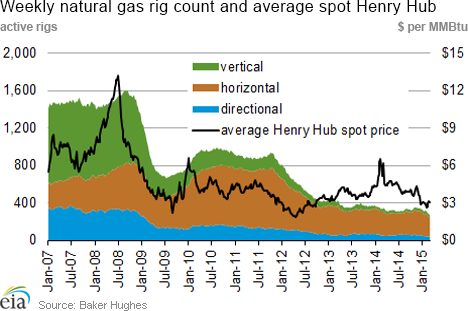
| Rigs | |||
|---|---|---|---|
Fri, March 06, 2015 |
Change from |
||
last week |
last year |
||
| Oil rigs | 922 |
-6.49% |
-36.11% |
| Natural gas rigs | 268 |
-4.29% |
-22.32% |
| Miscellaneous | 2 |
100.00% |
-50.00% |
| Rig numbers by type | |||
|---|---|---|---|
Fri, March 06, 2015 |
Change from |
||
last week |
last year |
||
| Vertical | 177 |
-8.76% |
-54.85% |
| Horizontal | 895 |
-5.39% |
-25.54% |
| Directional | 120 |
-5.51% |
-39.39% |
| Source: Baker Hughes Inc. | |||
| Working gas in underground storage | ||||
|---|---|---|---|---|
Stocks billion cubic feet (bcf) |
||||
| Region | 2015-03-06 |
2015-02-27 |
change |
|
| East | 618 |
722 |
-104 |
|
| West | 339 |
355 |
-16 |
|
| Producing | 555 |
633 |
-78 |
|
| Total | 1,512 |
1,710 |
-198 |
|
| Source: U.S. Energy Information Administration | ||||
| Working gas in underground storage | |||||
|---|---|---|---|---|---|
Historical comparisons |
|||||
Year ago (3/6/14) |
5-year average (2010-2014) |
||||
| Region | Stocks (Bcf) |
% change |
Stocks (Bcf) |
% change |
|
| East | 444 |
39.2 |
780 |
-20.8 |
|
| West | 172 |
97.1 |
274 |
23.7 |
|
| Producing | 413 |
34.4 |
683 |
-18.7 |
|
| Total | 1,029 |
46.9 |
1,737 |
-13.0 |
|
| Source: U.S. Energy Information Administration | |||||
| Temperature -- heating & cooling degree days (week ending Mar 05) | ||||||||
|---|---|---|---|---|---|---|---|---|
HDD deviation from: |
CDD deviation from: |
|||||||
| Region | HDD Current |
normal |
last year |
CDD Current |
normal |
last year |
||
| New England | 302
|
72
|
-19
|
0
|
0
|
0
|
||
| Middle Atlantic | 290
|
72
|
-27
|
0
|
0
|
0
|
||
| E N Central | 339
|
108
|
-20
|
0
|
-1
|
0
|
||
| W N Central | 344
|
113
|
-34
|
0
|
0
|
0
|
||
| South Atlantic | 163
|
28
|
-29
|
14
|
4
|
7
|
||
| E S Central | 167
|
37
|
-23
|
1
|
-2
|
1
|
||
| W S Central | 159
|
76
|
6
|
1
|
-7
|
-2
|
||
| Mountain | 224
|
47
|
59
|
0
|
-1
|
-1
|
||
| Pacific | 106
|
11
|
22
|
0
|
-1
|
0
|
||
| United States | 238
|
66
|
-8
|
3
|
0
|
1
|
||
|
Note: HDD = heating degree-day; CDD = cooling degree-day Source: National Oceanic and Atmospheric Administration | ||||||||
Average temperature (°F)
7-Day Mean ending Mar 05, 2015
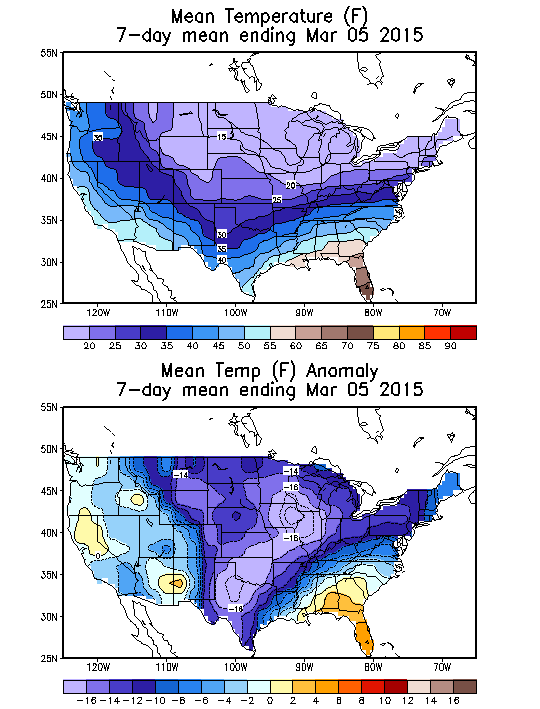
Source: NOAA/National Weather Service
Deviation between average and normal (°F)
7-Day Mean ending Mar 05, 2015

Source: NOAA/National Weather Service

